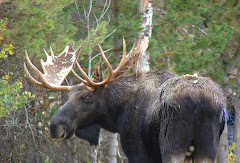I recently went out on the San Lorenzo River with a county staff person to evaluate potential release sites for Monterey Bay Salmon & Trout Project's "Trout in the Classroom" fish. Each year, teachers who have taken a special course are given thirty wild steelhead eggs to raise in a classroom aquarium, so the students can see how the fry emerge from the gravels and grow for the first few weeks of their lives. When they are big enough, they are returned to the stream where they were spawned... in this case, the San Lorenzo River.
The goal is to make sure the little steelhead are released into an area where they can have access to forage and escape cover. While we were out wandering around, we got a few nice surprises. Like this Pacific lamprey, holding in a bend at Henry Cowell State Park.

I know she's hard to see, but she's there. From how beaten up she is I'd say she is probably spawned out, and I don't know if she'll die here or try to get back out to sea. While we were there, she stayed fastened to her rock and didn't move.
A bit further upstream, we said to each other "gosh I hope all the steelhead in the river went back out to sea with the May 1 storm and that no new ones came in...", walk around the bend, and voila!

We were at Highlands Park, near a ledgy bedrock outcrop, so this big guy was really easy to see. He had obviously been in the stream for a while since he was nice and reddened up, but looked to be in great shape, if a little thin. As we watched, he drifted to and fro against the far bank, back into the middle of the channel, then finally glided over the edge of the falls and back downstream. He had quite a ways to go.
After we exclaimed over that treat, we walked a bit further upstream only to hear a loud "PLOP." Of course, that means "frog." and upon further investigation, we located the culprit, hidden beneath a willow tree in a backwater.

at first, because he was so hard to see with only his head sticking out of the water, I got all excited that it was a redlegged frog. But, after getting home and looking at my pictures more closely, alas, it was a bullfrog. Bah.
And here's the part about life giving you lemons. I saw two at-risk native species, and one invasive, all in one day, all in an urban stream, without even trying. So what do I want to focus on, the fact that the invasives are really gaining ground and the natives are becoming fewer and farther between? Well, it's a choice. I choose to look at what I can do to help the natives rebound.
As far as getting to see creatures in their natural settings, I know many of you probably have never seen a lamprey. or a steelhead, or even a bullfrog. Even if you think you spend at lot of time outdoors. Luck? Maybe. But you can go find these things too. Just get out of your car, shut off your cellphone, tell your kids that it is "quiet time" and they need to zip it. If you usually run along a trail next to a stream, try walking. If you slow down, you will take in a lot more of your surroundings that you never noticed before. You just never know what you might find.
If you're in Alum Rock Park, at the head of the springs trail, and you just happened to look up, you might have seen these:

A female great horned owl and one of her fledglings, sitting in a tree, in broad daylight. Get out there and look! And for what it's worth, I am quite partial to meyer-lemon-mint lemonade.














